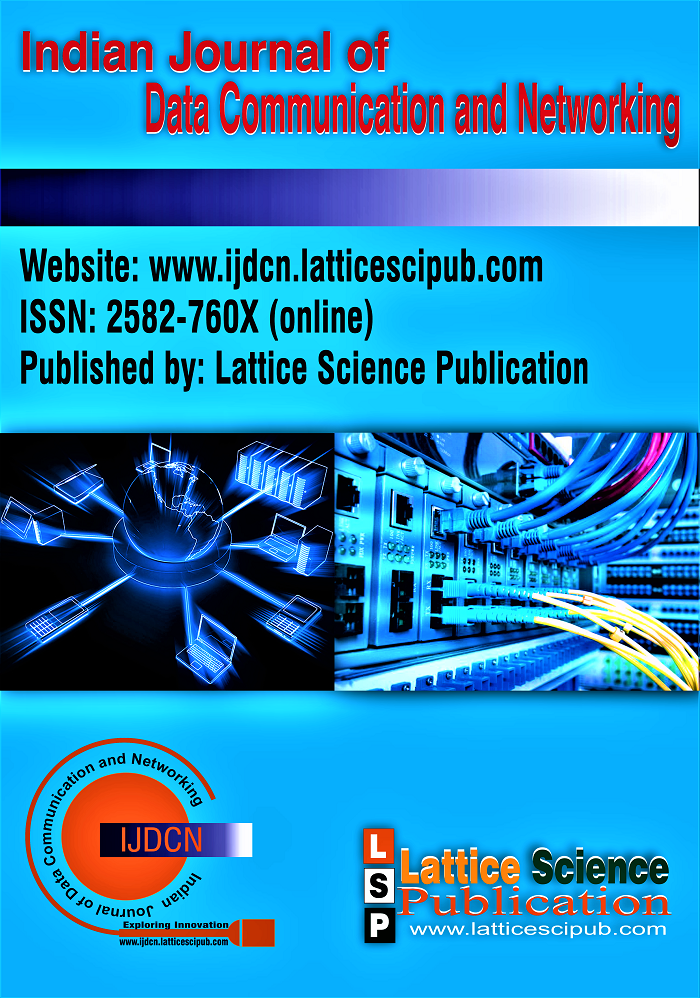SALP Swarm Optimization Approach for Maximization The Lifetime of Wireless Sensor Network
Main Article Content
Abstract
In recent years, the maximization of a lifetime for wireless sensor networks is considered an important area for researchers. The wireless sensor networks (WSNs) contain two types of sensors that called sensor nodes and sink nodes which sensor node send information to the central node (sink node) that collected its data. Choosing the best location of sink node considered the critical problem that faces the lifetime of wireless sensor networks. In this paper, we propose a method that choosing best location of a sink node by applying Salp Swarm Algorithm (SSA) after determining sink node location we create transmission paths between the sink node and rest of nodes using Prim’s minimum spanning tree to choose shortest paths. Accordingly, for fitness function that used to decrease energy consumption for a network. Simulation results clarify that our proposed algorithm that solves localization of sink node presents the best results for prolonging the network’s lifetime compared to Cat Swarm Optimization algorithm (CSA) and Particle Swarm Optimization (PSO).
Downloads
Article Details

This work is licensed under a Creative Commons Attribution-NonCommercial-NoDerivatives 4.0 International License.
How to Cite
References
F. Akyildiz, W. Su, Y. Sankarasubramaniam, E. Cayirci, A survey on sensor networks, IEEE Communications magazine 40 (8) (2002) 102{114. [CrossRef]
J. I. Espinosa-Ramos, et al., A new objective function to build seismic net-works using di erential evolution, in: Evolutionary Computation (CEC), 2012 IEEE Congress on, IEEE, 2012, pp. 1{7. [CrossRef]
M. M. Ahmed, A. Taha, A. E. Hassanien, E. Hassanien, An optimized k-nearest neighbor algorithm for extending wireless sensor network lifetime, in: International Conference on Advanced Machine Learning Technologies and Applications, Springer, 2018, pp. 506{515. [CrossRef]
V. Snasel, L. Kong, P. Tsai, J.-S. Pan, Sink node placement strategies based on cat swarm optimization algorithm, J. Netw. Intell 1 (2) (2016) 52{60.
M. M. Fouad, V. Snasel, A. E. Hassanien, Energy-aware sink node lo-calization algorithm for wireless sensor networks, International Journal of Distributed Sensor Networks 11 (7) (2015) 810356. [CrossRef]
M. M. Ahmed, E. H. Houssein, A. E. Hassanien, A. Taha, E. Hassanien, Maximizing lifetime of wireless sensor networks based on whale optimization algorithm, in: International Conference on Advanced
Intelligent Sys-tems and Informatics, Springer, 2017, pp. 724{733. [CrossRef]
R. Yadav, V. Kumar, R. Kumar, A discrete particle swarm optimization based clustering algorithm for wireless sensor networks, in: Emerging ICT for Bridging the Future-Proceedings of the 49th Annual Convention of the Computer Society of India CSI Volume 2, Springer, 2015, pp. 137{144. [CrossRef]
P. M. Wightman, M. A. Labrador, A3: A topology construction algorithm for wireless sensor networks, in: Global Telecommunications Conference, 2008. IEEE GLOBECOM 2008. IEEE, IEEE, 2008, pp. 1{6. [CrossRef]
P. Santi, Topology control in wireless ad hoc and sensor networks, ACM computing surveys (CSUR) 37 (2) (2005) 164{194. [CrossRef]
M. M. M. Fouad, A. R. Dawood, M. M. Mostafa, Study of the e ects of pairwise key pre-distribution scheme on the performance of a topology control protocol.
A. Efrat, S. Har-Peled, J. S. Mitchell, Approximation algorithms for two optimal location problems in sensor networks, in: Broadband networks, 2005. BroadNets 2005. 2nd international conference on, IEEE, 2005, pp. 714{723.
E. I. Oyman, C. Ersoy, Multiple sink network design problem in large scale wireless sensor networks, in: Communications, 2004 IEEE International Conference on, Vol. 6, IEEE, 2004, pp. 3663{3667. [CrossRef]
H. Kim, Y. Seok, N. Choi, Y. Choi, T. Kwon, Optimal multi-sink position-ing and energy-e cient routing in wireless sensor networks, in: Interna-tional Conference on Information Networking, Springer, 2005, pp. 264{274. [CrossRef]
S. Mirjalili, A. H. Gandomi, S. Z. Mirjalili, S. Saremi, H. Faris, S. M. Mirjalili, Salp swarm algorithm: a bio-inspired optimizer for engineering design problems, Advances in Engineering Software 114 (2017) 163{191. [CrossRef]
M. Hazewinkel, Greedy algorithm, encyclopedia of mathematics (2001).
B. Y. Wu, K.-M. Chao, Spanning trees and optimization problems (ex-cerpt).
D. Cheriton, R. E. Tarjan, Finding minimum spanning trees, SIAM Journal on Computing 5 (4) (1976) 724{742. [CrossRef]
R. M. Rizk-Allah, A. E. Hassanien, A hybrid optimization algorithm for single and multi-objective optimization problems, in: Handbook of Re-search on Machine Learning Innovations and Trends, IGI Global, 2017, pp. 491{521. [CrossRef]
A. Tharwat, E. H. Houssein, M. M. Ahmed, A. E. Hassanien, T. Gabel, Mogoa algorithm for constrained and unconstrained multi-objective opti-mization problems, Applied Intelligence (2017) 1{16. [CrossRef]
M. A. Labrador, P. M. Wightman, Topology Control in Wireless Sensor Networks: with a companion simulation tool for teaching and research, Springer Science & Business Media, 2009.
P. M. Wightman, M. A. Labrador, A3cov: a new topology construction protocol for connected area coverage in wsn, in: Wireless Communications and Networking Conference (WCNC), 2011 IEEE, IEEE, 2011, pp. 522{ 527. [CrossRef]
E. H. Houssein, M. M. Ahmed, M. A. Elaziz, A. A. Ewees and R. M. Ghoniem, "Solving Multi-Objective Problems Using Bird Swarm Algorithm," in IEEE Access, vol. 9, pp. 36382-36398, 2021, doi: 10.1109/ACCESS.2021.3063218. [CrossRef]





